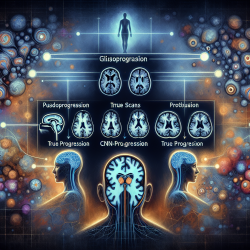Introduction
In the realm of medical imaging, distinguishing between pseudoprogression and true progression in diffuse infiltrating gliomas is a formidable challenge. The advent of deep learning, specifically the use of convolutional neural networks (CNN) combined with long short-term memory (LSTM) networks, presents a promising solution. This blog explores how practitioners can leverage these advanced technologies to improve diagnostic accuracy and patient outcomes.
The Challenge
Gliomas, particularly high-grade ones, often present a diagnostic conundrum. Post-treatment MRI scans may show changes that mimic tumor progression, known as pseudoprogression. Differentiating this from true progression is crucial for timely and appropriate treatment decisions. Traditional methods, including surgical biopsies, are invasive and sometimes inconclusive. Thus, there's a pressing need for non-invasive, accurate diagnostic tools.
The Study
The study titled "Discriminating pseudoprogression and true progression in diffuse infiltrating glioma using multi-parametric MRI data through deep learning" offers an innovative approach. By utilizing a combination of multi-parametric MRI data and a CNN-LSTM model, researchers have developed a method that significantly enhances diagnostic performance.
Key Findings
- The CNN-LSTM model, which incorporates multiple MRI sequences, outperformed traditional CNN models that rely on single MRI sequences.
- The model achieved a mean accuracy ranging from 0.62 to 0.75 and a mean AUC (Area Under the Curve) from 0.64 to 0.81, indicating robust diagnostic capabilities.
- Incorporating all available MRI sequences into the CNN-LSTM model provided a comprehensive analysis, leveraging correlations between different sequences.
Implications for Practitioners
For practitioners, the implications are profound. By adopting a CNN-LSTM approach, medical professionals can:
- Enhance diagnostic accuracy, reducing the risk of misdiagnosis and subsequent treatment delays.
- Provide a non-invasive alternative to surgical biopsies, improving patient comfort and safety.
- Utilize a comprehensive data set that includes engineered sequences, offering a more detailed analysis of tumor characteristics.
Encouraging Further Research
While the study presents promising results, it also highlights the need for further research. Practitioners are encouraged to engage with ongoing studies and contribute to expanding the dataset, which will enhance the model's accuracy and reliability. Collaboration with research institutions and participation in clinical trials can also accelerate the adoption of these advanced diagnostic tools.
Conclusion
The integration of deep learning models like CNN-LSTM in medical imaging is a game-changer for diagnosing gliomas. By embracing these technologies, practitioners can improve diagnostic accuracy and patient outcomes, paving the way for more personalized and effective treatment strategies.
To read the original research paper, please follow this link: Discriminating pseudoprogression and true progression in diffuse infiltrating glioma using multi-parametric MRI data through deep learning.










